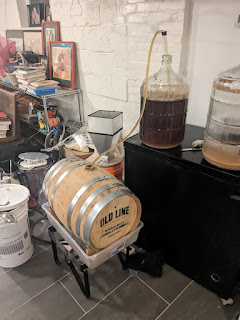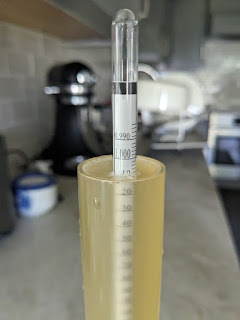Pseudo-Kvass Parti-Gyle
As I’m sure is clear from the name, this is a weird one. As the weather gets a little bit colder (and kegged beers stack up in our basement), we’ve been doing some weirder, more long-term brews that we can age and forget about for a few months or more. Partly, we’re developing a taste for funkier, richer flavors in our beer, partly I think we just want to keep brewing and we have so much kegged beer right now that it’s hard to justify a brew that will be ready to drink in 4 weeks or less.
This is also by far the largest run we’ve ever made - 20 gallons in our fermentors is ludicrous for us and it definitely put us through our paces. Luckily, we bought a new, much larger cooler that Luke managed to convert into a mash tun with just a little bit of effort. Frankly, it was still a little small for what we were trying to do, but it will make things easier from here on out.
The reason we embarked on this herculean effort at all was because we decided that the beer in our 10 gallon barrel had been sitting in there long enough. Barrels can’t be empty though, so we had to fill it with something; a barleywine seemed perfect for a nice, long-aging beer. The last time we did a barleywine, we also split the batch in a technique known as “parti-gyle,” where the first runnings make a big, heavy beer and subsequent runnings are used for a smaller beer. Things got a little trickier when we were actually brewing - no plan survives contact with the enemy - but we’re pretty happy with how it came out.In preparation for this brew, I’d been saving loaves of my sourdough bread that were getting stale and drying them out in the oven. Each loaf has about 600 grams of flour in it as well as about 11 grams of sea salt. In Eastern Europe, kvass is a traditional fermented beverage made from stale bread in exactly this way. The jury is still out on exactly how much fermentable sugar you can get from the wheat this way, but kvass is usually not very alcoholic, so we’re probably getting more flavor than we are sugar.
The first mash had just an incredible amount of grain. The mash tun holds 17 gallons and I’m still surprised we got as much water in there as we did. The grain is also extremely thirsty at that level - something I wasn’t fully prepared for. We managed to get 11.5 gallons of water onto almost 46 lbs of grain, but only 5.5 gallons out of that first run. I had naively hoped to get 15 gallons onto the grain and pull out 11.5. Not a chance!
This is where we started improvising. We could have sparged to get up to our pre-boil volume for the barleywine, but then there wouldn’t have been much sugar left for the next beers. Instead, we decided to do the second mash next, and then a large sparge that we would split up between the two.
We added the pale rye malt, the bread, and the water it was soaking in (perhaps a gallon) onto the mash and then added as much water as we could fit, which turned out to only be about 3 more gallons. After letting that mash for about 45 minutes, we pulled it off into our second kettle and began sparging, using our old mash tun to hold the runnings. This took a while, since we couldn’t fit more than a few gallons of water in the mash tun at any one point, but we got there in the end and split it between the two kettles to bring both to 12 gallons.For the barleywine, we hopped it as a pretty standard American barleywine. The bittering addition was a mix of some older hops we had lying around to bring us up to about 60 IBU (necessary for balancing the richness of all that sugar), and then we used some whole cone Citra hops for the 10 minute addition and the whirlpool.
The second runnings, we decided to split after the boil. One will get IPA yeast and a dry hop and the other will get saison yeast and no dry hop. With that in mind, we bittered to just shy of 20 IBU (again with some older hops) and did a reasonably substantial whirlpool. I’m reading Scott Janish’s book, The New IPA, and in it, he recommends splitting your whirlpool between 200 degrees and 180 degrees. The 160 degree standard I had been following up to this point apparently adds vegetal flavors and less of the compounds we want to survive into the finished beer.
We also followed Scott Janish’s advice in selecting our hops. Idaho 7 and Citra are both extremely high in the survivable compounds that are extracted in a whirlpool. Experimental ID-158 is a new hop from the makers of Idaho 7 with similar characteristics, so it seems logical that it will also be high in survivables. In the light of day (I am writing this the morning after brewing on rather little sleep), the only thing I would have done differently is to increase the whirlpool addition up to Janish’s recommended 7g/l - a rate of almost 10 oz of whirlpool hops!
When we finally finished the whirlpool rest and cooled all the wort down it was close to 1 am. Clearly we ought to have gotten started earlier in the day. We managed to get the saison and the IPA into corny kegs, pitched, hooked up to blowoff tubes, and resting comfortably in our very high tech mini-fridge-with-an-inkbird setup. We got the barleywine into the barrel, pitched it with two packets of high-gravity Belgian yeast, cleaned up and called it a day.
I’m looking forward to drinking the IPA in the relatively near future, but everything else is going to be fermenting for some time. We’re planning to pitch a bit of brett into the saison and let it get a bit funky over the next 8 weeks or so before we bottle it up. The barleywine is going to be the real long-distance runner. A beer this big takes quite a bit of time to fully ferment even with high-gravity brewer’s yeast. We’re planning to give the brett in the barrel plenty of time to work its magic with this one, especially because we don’t have a good way to control heat in the barrel. Belgian yeasts tend to produce fusel alcohols when they get too hot during initial fermentation, which produce an unpleasant “hot” flavor. These fusel alcohols can turn into esters over time, but that can take as much as six months.
And unspoken in all of this is that we don’t really know how the bread addition is going to affect things! I’ve added a loaf of bread to a few beers before, and both turned out pretty well, but three loaves is by far the largest bread addition I’ve made. I love sourdough baking and I was a Russian major in undergrad, so adding a bit of Kvass to our brews is really exciting for me personally!
Stats:
Volume in Fermentor: 10 Gallons / 5 Gallons / 5 Gallons
Starting Gravity: 1.08 / 1.044 / 1.044
Water:
- 11.5 Gallons Step Mash 1
- 4 Gallons Step Mash 2
- 15.5 Gallons Fly Sparge
Fermentables:
Mash 1
- 20 lbs Crisp Maris Otter
- 20 lbs Briess Pale Malt
- 4 lbs Munich Malt
- 1.5 lbs Caramel Malt 60L
- 2 oz Carafa II
- 1 lb Belgian Candi Sugar
Mash 2
- 4 lbs Pale Rye Malt
- 3 loaves Sourdough Bread (600g loaves)
- Second runnings from Step Mash 1
Bittering/Flavoring Additions:
Mash 1
- 0.7 oz Amarillo @ 60M
- 2.2 oz Citra @ 60M
- 1 oz Citra @ 10M
- 3.5 oz Citra @ Whirlpool (200F)
Mash 2
- 1 oz Amarillo @ 60M
- 1 oz Exp ID-158 @ Whirlpool (200F)
- 0.5 oz Idaho 7 @ Whirlpool (200F)
- 0.5 oz Citra @ Whirlpool (200F)
- 1 oz Exp ID-158 @ Whirlpool (180F)
- 0.5 oz Idaho 7 @ Whirlpool (180F)
- 0.5 oz Citra @ Whirlpool (180F)
- Mash 2 (IPA Fermentor)
- 2 oz Citra LupoMax @ Dry Hop (~60F)
- 1 oz Cascade @ Dry Hop (~60F)
- 1.5 oz AU Galaxy @ Dry Hop (~60F)
Other:
- 10g Calcium Chloride*
- 10g Epsom Salt*
- 1 tsp Yeast Nutrient
- 2 lb Rice Hulls
Microbes:
- Fermentor A: 2 pkt Wyeast High Gravity Belgian + Barrel Microbes
- Fermentor B: 1 pkt Lallemand Verdant IPA
- Fermentor C: 1 pkt Wyeast Belgian Saison
Schedule:
- Mash for 60 minutes at 150F with “Mash 1” fermentables, then drain to first kettle
- Mash for 45 minutes at 150F with “Mash 2” fermentables added on top of spent “Mash 1” fermentables, then drain to second kettle
- Fly sparge until sufficient volume is reached for each kettle to reach 12 gallons of pre-boil wort
- Boil for 60 minutes, adding hops, nutrient, and irish moss according to schedule
- Cool, transfer to fermenters, oxidate and add yeast
Notes:
* These additions are specific to Maryland-area water chemistry, calculated using EZ Water Calculator



Comments
Post a Comment